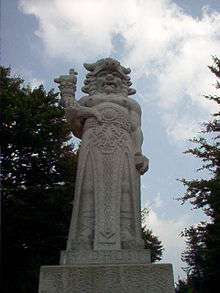Radegast (god)
Radegast, also Radigost, Redigast, Riedegost or Radogost is an old, well-documented,[1] god of Slavic mythology. Since the name can easily be etymologised as meaning something like “Dear guest” or “Gladly guest”, Radegast was proclaimed as the Slavic god of hospitality and as such entered the hypothetical, reconstructed Slavic pantheon of modern days. Even myths concerning him were constructed based on various folk customs of sacred hospitality. Similar customs, however, are known in many Indo-European mythologies without a distinct deity associated explicitly with them. Another possible etymology may be from Slavic "rada" - council, and "gościć", "hostit", "goszczący" - to host, Radogost being the name of the council or assembly host, leader, or speaker, and one of the attributes of the god. This view could be supported by the political role Radegast temple played in the life of West Slavic tribes. According to some literary sources he is also the god of war, night, fire and the evening sky.[2] He is completely black, is armed with a spear and helmet, and it pleases him to be invited to banquets.
History
Mt. Radhošť, in the Moravian-Silesian Beskids mountain range, is traditionally associated with the worship of this god; according to legend, missionaries Cyril and Methodius when they reportedly visited the mountain on their trip to Great Moravia, had his idol demolished.
Radegast is mentioned by Adam of Bremen in his Gesta Hammaburgensis Ecclesiae Pontificum as the deity worshipped in the Lutician (West Slavic tribes) city of Radgosc. Likewise, Helmold in his Chronica Slavorum wrote of Radegast as a Lutician god. However, Thietmar of Merseburg earlier wrote in his Chronicon that the pagan Luticians in their holy city of "Radegast" worshipped many gods, the most important of which was called Zuarasici, identified as either Svarog or Svarožič. According to Adam of Bremen, Johannes Scotus, Bishop of Mecklenburg, was sacrificed to that god on 10 November 1066, during a Wendish pagan rebellion against Christianity.
According to Slavic legends, Radegast was beloved by Hors, described as the beautiful young goddess of the moon. However he ignored her, unlike the god of the wind Stribog, who loved her. Stribog secretly stole Radegast's cloak and towards morning he sneaked into Hors chamber, where she let him seduce her and got her pregnant. Radegast was outraged, but not because of Hors rather for the stolen coat. Hors felt cheated and lonely. She begged for mercy for her newborn girl and suggested that she could be a goddess of autumn, but the main god Svarog disagreed and the dispute was not settled. As a result, this season does not have a goddess and the goddess Živa fights over it with the goddess Marzanna.[2]
In popular culture
The original statue once found on Mt. Radhošť, sculpted in 1929 by Albin Polasek, is now located in Frenstat's (Czech Republic) Town Hall. When the statue was moved to the mountain in 1931, the truck became stuck in a steep turn, and heavy rain accompanied by storm and lightning killed one of the soldiers.[3] A second cast by Albin Polasek stands in the center of Prague's Zoo.
The granite version, now found on Mt. Radhošť, is a more recent copy funded by the Radegast Beer Company in 1998. More information and sculptures of Radegast can be viewed at The Albin Polasek Museum & Sculpture Gardens in Winter Park, Florida. The name Radhošť itself is supposed to be a Czech transcription of Radegast.
Radagast the Brown is a fictional character in J. R. R. Tolkien's Middle-earth legendarium. He is one of the wizards and lives among animals. Radigost is also the name of a Russian black metal band formed in 1994, as well as Radogost being the name of a folk metal band from Poland formed in 2006.
References
- ↑ Modern Pagan and Native Faith Movements in Central and Eastern Europe. Ed. Kaarina Aitamurto, Scott Simpson. Routledge, 2013. P. 49 ff.
- 1 2 Book Báje a mýty starých slovanů by Ivan Hudec, Slovart, 1994
- ↑ Pohanský bůh Radegast
Further reading
- Thietmar of Merseburg, Chronicon.
- Adam of Bremen, Gesta Hammaburgensis Ecclesiae Pontificum.
- Helmold, Chronicon Slavorum.
- Masius (Hector Gottfried) - Hectoris Gothofredi Masii Mecklenburgensis Schediasma historico-philologicum de diis Obotritis seu idolis Mecklenburgensium & præcipue de Radegasto celebri olim idolo, Hafniae (Copenhagen), Bockenhoffer, 1688
External links
-
 Media related to Radegast (deity) at Wikimedia Commons
Media related to Radegast (deity) at Wikimedia Commons

